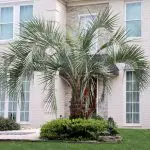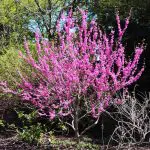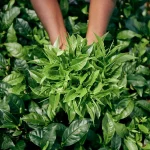This post contains affiliate links. If you buy something from one of our links we may earn a commission. Thanks
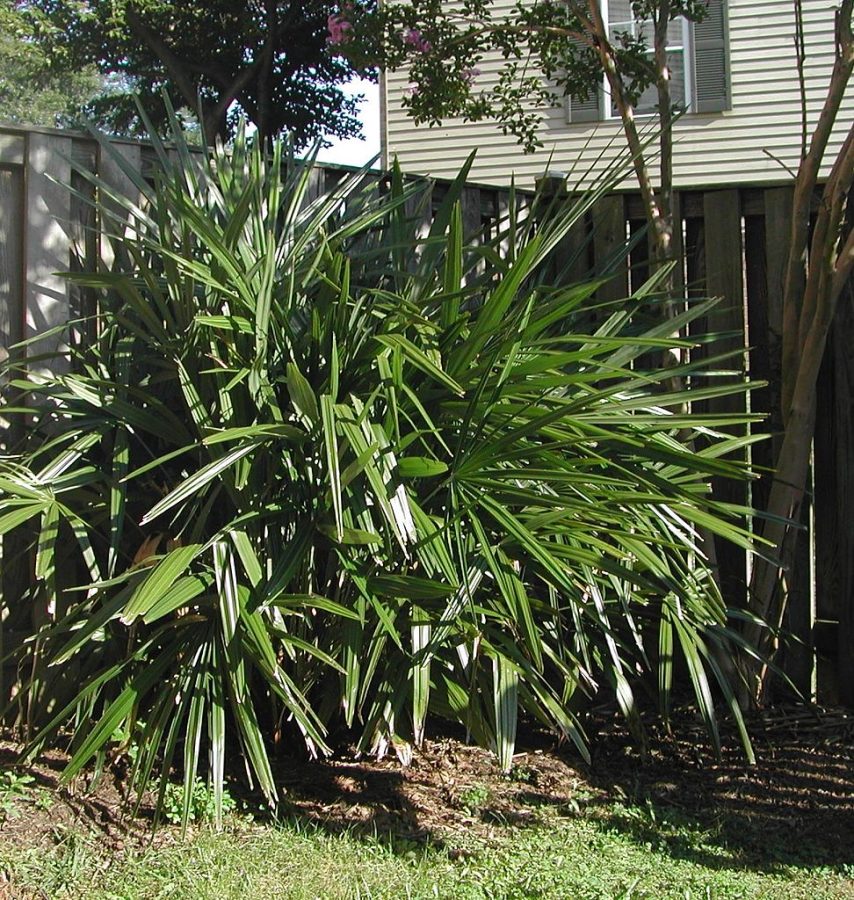
Looking to add some tropical flair to your home or garden? Needle Palm Tree Care is easier than you might think!
Needle palm (Rhapidophyllum hystrix) care involves placing the plant in partial to full shade, ensuring well-draining soil, and watering it regularly to keep the soil moist. During the growing season, a balanced slow-release fertilizer can be applied to support its growth.
With a few simple tips, you can keep your palm tree healthy and vibrant all year round. Let’s get started!
Hey there, plant enthusiasts! If you’re looking to add a touch of the tropics to your garden or home, a needle palm tree is a perfect choice.
This unique plant is known for its striking appearance and hardiness, making it an excellent option for both indoor and outdoor spaces.
However, to ensure your needle palm tree thrives, it’s essential to give it the right care.
In this post, we’ll provide you with all the tips you need for successful Needle Palm Tree Care, so you can enjoy its lush foliage and exotic beauty for years to come.
What Is A Needle Palm Tree?
Known by its common name the Needle palm (Rhapidophyllum hystrix) is a slow-growing, clumping palm that is native to the southeastern United States.
These small plants make an attractive plant that can grow up to 6 feet tall, and it is known for its long, sharp black needles that grow along the base of the plant.
They are shrub-like palms that are slow-growing and suitable for use as container-grown plants.
The needle palm tree is a hardy plant that can tolerate extreme weather conditions, including drought, cold temperatures, and wind.
Cold Hardy Needle Palm Trees
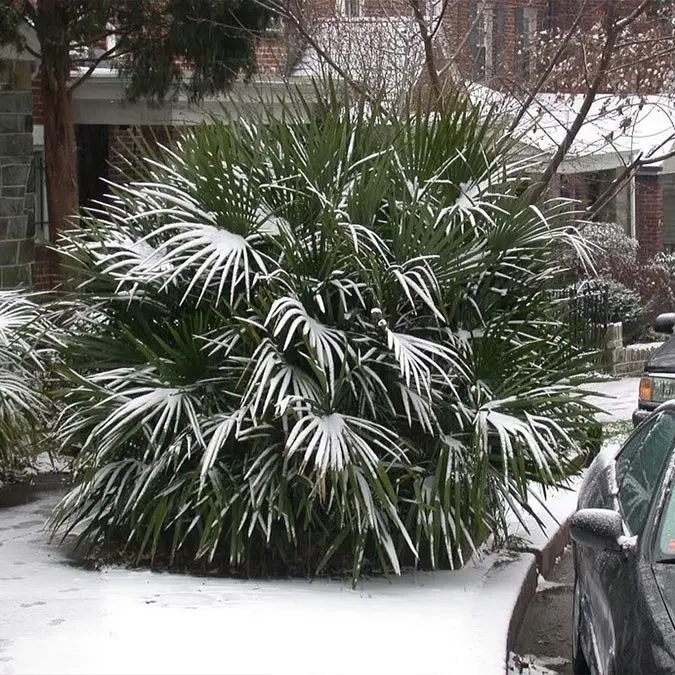
The Needle Palm may well be the hardiest palm known for its remarkable cold tolerance, being able to withstand harsh winters with temperatures as low as -15F.
This makes it an ideal choice for growing in a wide range of climates, from USDA Zones 5b (-15 to -10 F) all the way up to Zone 11 (above 40 F).
Its unique characteristics make it a great choice for those looking to add a tropical look to their garden or home and for those in colder climates.
According to Wikipedia: The needle palm is very popular among palm enthusiasts in temperate climates for its ability to tolerate modest cold. Some reports have claimed survival of temperatures as low as −26 °C (−15 °F) with heavy damage, but with the palm recovering. More realistic estimates are closer to −21 °C (−5 °F) with foliar damage. Recovery of winter damage of needle palms is much more precarious in climates with cool summers like the Pacific NW (USA/Canada), NW Europe.
Needle Palm Quick Facts
| Mature Height: | 3-9 ft |
| Mature Width: | 6-8 ft |
| Sunlight: | Full Sun |
| Growth Rate: | Slow |
| Botanical Name: | Rhapidophyllum hystrix |
| Grows Well In Zones: | 7-10 outdoors |
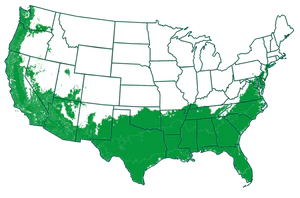
More Cold Hardy Palms
The windmill palm (Trachycarpus fortunei) comes close but is only hardy to 0°.
Sabal minor or Dwarf Palmetto is another palm similar to and is hardy to near 0°.
The European Fan Palm is hardy to 10 degrees and is the only palm native to Europe.
If you want a palm you can leave it outdoors all year long even in colder climates these are 3 types of palms worth trying.
The benefits of growing a needle palm tree indoors
Growing a needle palm tree indoors offers several benefits, such as adding a unique focal point to your home decor.
It can also help to purify the air by removing harmful toxins and adding moisture to the air.
Indoor needle palm trees are relatively low-maintenance and do not require much attention, making them an excellent choice for busy homeowners.
They also offer a year-round tropical vibe to any living space, making them a great choice for those who want to bring a touch of the outdoors inside.
Needle Palm Tree Care
Proper care is essential for the growth and development of an indoor needle palm tree. So let’s get into it!
Choosing A Pot For Your Needle Palm Tree
Choosing the right pot size for your needle palm tree is crucial to its growth and development.
A pot that is too small can restrict the plant’s growth, while a pot that is too large can cause the soil to retain too much moisture, leading to root rot.
In this section, we’ll cover the essential factors to consider when choosing a pot for your needle palm tree, so you can provide it with the best possible growing conditions.
When choosing a pot, select one that is slightly larger than the current size of the root ball to allow for growth
As needle palm trees prefer to be slightly root-bound, it’s not necessary to repot frequently
Repot only when the roots begin to outgrow the current container or if the soil is depleted and no longer provides adequate nutrients for the palm tree.
Guidelines on choosing the right size pot for an indoor needle palm tree
When selecting a pot for your indoor needle palm tree, it’s crucial to consider the size of the plant.
Choose a pot that is only slightly larger than the root ball of the plant, as this will allow enough room for the roots to grow and help prevent over-watering.
Generally, a pot with a diameter of 2-4 inches larger than the current pot is a good choice for needle palm trees.
Soil And Drainage For Indoor Needle Palm Trees
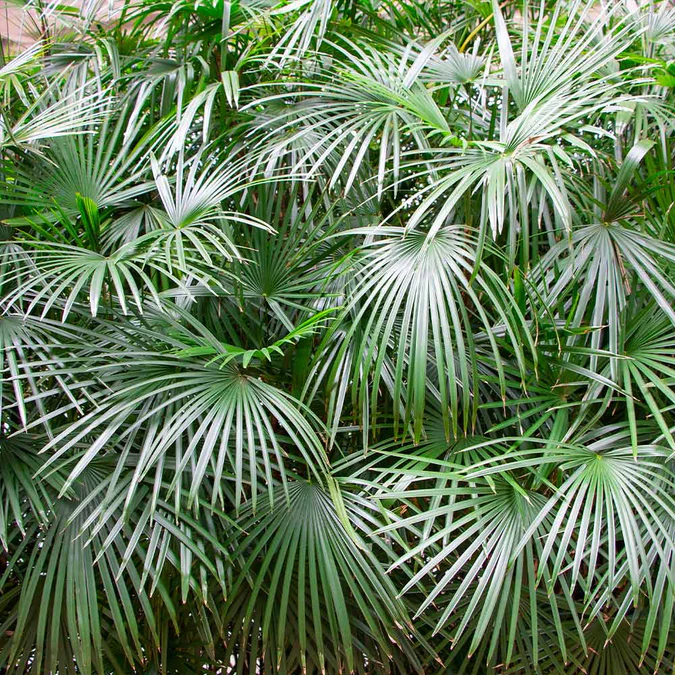
The right soil conditions are crucial for healthy needle palm tree growth so avoid wet soils like heavy clay soils if planting outdoors.
Needle palm trees prefer well-drained soil that retains moisture, so it’s essential to choose the right type of potting soil.
Coco coir is an ideal choice for needle palm trees as it is a natural, renewable resource that retains moisture and provides excellent drainage.
It is recommended to mix equal parts of coco coir and perlite for added drainage.
Avoid using regular garden soil or heavy potting mix, as they can retain too much moisture and cause root rot.
It’s also crucial to ensure proper drainage by choosing a pot with drainage holes at the bottom.
This will allow excess water to drain out and prevent the roots from sitting in water, which can lead to root rot.
Lighting
Proper lighting is essential for the growth and health of your indoor needle palm tree.
While needle palm trees can tolerate low-light conditions, they still require adequate light to thrive.
In this section, we’ll discuss the lighting requirements for indoor needle palm trees and provide tips on how to ensure your plant gets the right amount of light.
The lighting needs of a needle palm tree when grown indoors
Needle palm trees can tolerate low-light conditions, but they still require bright, indirect light to thrive.
When grown indoors, place the plant near a bright window that receives partial shade to full sun for several hours a day.
Rotate the plant regularly to ensure even growth and prevent it from leaning towards the light source.
If you notice the leaves turning yellow or brown, it may be a sign that the plant is not getting enough light.
How to ensure adequate light for an indoor needle palm tree
If your indoor space doesn’t receive enough natural light, you can supplement it with artificial light sources like LED grow lights.
Place the grow lights above the plant, and use a timer to keep them on for 12-14 hours a day.
Use full-spectrum LED grow lights, which provide a balance of the light that plants need for photosynthesis.
Avoid placing the plant too close to the grow lights, as this can burn the leaves.
Monitor the plant’s growth and adjust the lighting as needed to ensure it’s getting enough light.
Watering
Proper watering is crucial for the health and well-being of your indoor needle palm tree.
As with any plant, over or under-watering can lead to a host of issues, including root rot, wilting, and stunted growth.
In this section, we’ll discuss the watering needs of needle palm trees and provide guidelines on how to water your plant for optimal health and growth.
The watering needs of a needle palm tree indoors
Needle palm trees prefer moist but well-draining soil and they can tolerate periods of drought.
Over-watering is one of the most common causes of issues in indoor needle palm trees, as they can be prone to root rot in soil that is too wet.
Underwatering can also lead to issues, including leaf browning and wilting.
How often and how much water for a needle palm tree
When watering your indoor needle palm tree, it’s essential to ensure that the soil is moist but not waterlogged.
Water the plant thoroughly, allowing the water to drain out of the bottom of the pot.
Wait until the top inch of the soil is dry before watering again.
In general, needle palm trees require less frequent watering during the winter months when they are in their dormant phase.
The frequency of watering will depend on various factors, including the size of the pot, the amount of light the plant receives, and the humidity levels in your home.
A general rule of thumb is to water your indoor needle palm tree once a week, but monitor the soil moisture and adjust the watering frequency as needed.
Fertilizing
Proper fertilization is crucial for the growth and health of your indoor needle palm tree.
While these plants are relatively low-maintenance, they still require nutrients to thrive.
In this section, we’ll discuss the fertilization needs of needle palm trees and provide guidelines on how to fertilize your plant for optimal growth and health.
The importance of fertilizing an indoor needle palm tree
Fertilization is essential for the growth and overall health of an indoor needle palm tree, as it provides the necessary nutrients for the plant to thrive.
Indoor palm trees require a balance of essential macronutrients, including nitrogen, phosphorus, and potassium, as well as micronutrients like iron and magnesium.
How often and what type of fertilizer to use for
You can use high-quality, balanced palm fertilizers that are specifically formulated for palm trees. Most complete fertilizers that have micronutrients in their formula should also work well.
Fertilize your indoor needle palm tree every two to three months during the growing season, which typically runs from spring through fall.
During the winter months, when the plant is dormant, reduce the frequency of fertilization to once every three to four months.
When applying fertilizer, be sure to follow the package instructions carefully and avoid getting fertilizer on the leaves, as this can lead to burns.
Avoid over-fertilizing your indoor needle palm tree, as this can lead to nutrient burn and other issues.
Slow-release fertilizer spikes
Slow-release fertilizer spikes are a great option for indoor palm trees, as they provide a slow and steady release of nutrients over time.
The use of tree spikes will take the guesswork out of fertilizing. Here is what I recommend for  fertilizing your needle palm.
fertilizing your needle palm.
I recommend using Jobes Organics fertilizer spikes.
They are easy to use and last for 2-3 months.
They are designed for container-grown citrus but work great for container-grown palms.
Using 2 spikes for a 12-inch pot or 3 for an 18-inch pot takes the guesswork out of fertilizing.
They provide a 3-5-5 fertilizer blend along with micronutrients and beneficial bacteria.
Temperature and Humidity
Temperature and humidity are critical factors to consider when growing an indoor needle palm tree.
These plants are native to warm and humid climates, and they require specific temperature and humidity ranges to thrive.
In this section, we’ll discuss the ideal temperature and humidity levels for an indoor needle palm tree and provide guidelines on how to maintain these conditions for optimal growth and health.
Ideal temperature and humidity conditions
Needle palm trees prefer warm temperatures and high humidity levels.
The ideal temperatures for an indoor needle palm tree are between 65°F and 85°F (18°C to 29°C).
The ideal humidity range for an indoor needle palm tree is between 50% and 60%.
Tips on how to ensure the right temperature and humidity levels
Place your indoor needle palm tree in a warm, draft-free area of your home, away from air conditioning vents, fans, or other sources of cold air.
Use a humidifier or a pebble tray filled with water to increase the humidity levels around your indoor needle palm tree.
Avoid placing your indoor needle palm tree near heaters or radiators, which can cause the air to become too dry.
Regularly misting the leaves of your indoor needle palm tree with a spray bottle of water can also help to increase humidity levels.
If the air in your home is consistently dry, consider investing in a hygrometer to monitor the humidity levels around your indoor needle palm tree.
Remember, maintaining the ideal temperature and humidity conditions for your indoor needle palm tree is crucial for the plant’s health and growth.
With a little effort, you can help your needle palm tree thrive and create a lush, tropical atmosphere in your home.
Needle Palm Pruning and Maintenance
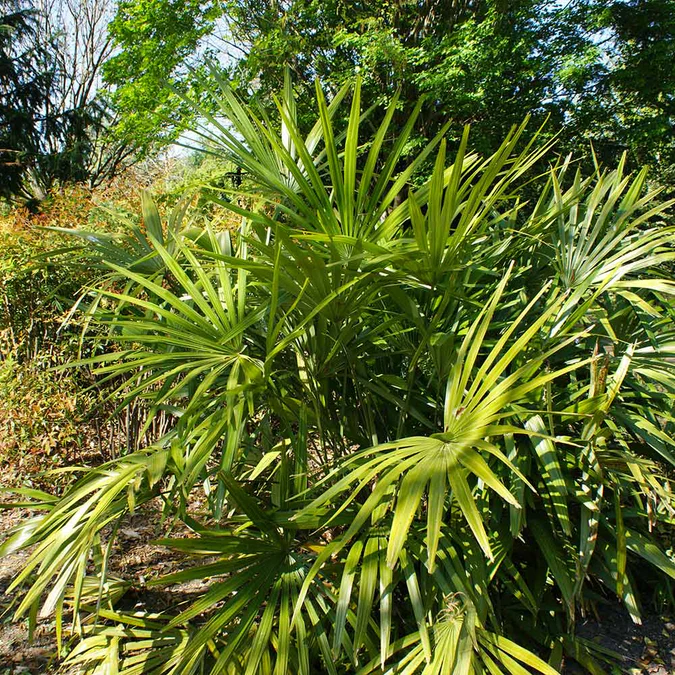
Maintaining an indoor needle palm tree is relatively easy, and with proper care, it can thrive for many years.
One of the key maintenance tasks for a needle palm tree is pruning.
While needle palms are slow-growing, they can grow quite tall and large over time, so it’s important to keep them under control.
Pruning
To prune your indoor needle palm tree, start by removing any yellow or dead fronds.
The best time to prune is spring through early summer. These fronds can be easily removed by cutting them off at the base with a sharp pair of pruning shears.
Watch out for those sharp needles when pruning. Be sure to also remove any damaged or diseased fronds, as these can spread disease to the rest of the tree.
You can also prune back any overly long or unruly fronds to maintain the tree’s shape.
When doing this, be careful not to remove too many fronds at once, as this can stress the tree.
Instead, try to space out your pruning over several weeks or months. Don’t prune any new growth.
Plant Inspection
In addition to pruning, it’s important to regularly inspect your indoor needle palm tree for any signs of pests or diseases.
If you notice any issues, be sure to address them promptly to prevent them from spreading.
With proper pruning and maintenance, your indoor needle palm tree can remain healthy and beautiful for many years to come.
Pests and Diseases
Pests and diseases can pose a significant threat to the health and well-being of your indoor needle palm tree.
These plants are generally hardy and disease-resistant, but they can still fall victim to common houseplant pests and fungal diseases.
In this section, we’ll discuss the most common pests and diseases that affect indoor needle palm trees and provide tips on how to prevent and treat these problems to keep your plant healthy and thriving.
Common pests and diseases
The most common pests that can affect an indoor needle palm tree include spider mites, scale insects, and mealybugs.
Common fungal diseases that can affect an indoor needle palm tree include leaf spot and root rot.
Tips on how to identify and treat any problems that arise
Spider mites can cause small, yellow speckles on the leaves of your indoor needle palm tree. You may also see webbing under the leaves.
To treat spider mites, rinse the leaves of your plant with water, and then spray them with insecticidal soap or neem oil.
Scale insects can cause small, raised bumps on the leaves and stems of your indoor needle palm tree.
To treat scale insects, use a cotton swab dipped in rubbing alcohol to remove the pests from the leaves of your plant.
Mealybugs can cause a cotton-like substance to appear on the leaves and stems of your indoor needle palm tree.
To treat mealybugs, spray the plant with a mixture of water and insecticidal soap.
Leaf spot can cause brown spots to appear on the leaves of your indoor needle palm tree.
To treat leaf spot, remove any affected leaves, and reduce watering to prevent over-saturation.
Root rot can cause the roots of your indoor needle palm tree to become brown and mushy.
To treat root rot, remove the plant from its pot, trim away any affected roots, and replant the palm in fresh, well-draining soil.
Remember, the best way to prevent pests and diseases from affecting your indoor needle palm tree is to provide proper care, including adequate watering, appropriate lighting, and regular fertilization.
By keeping a close eye on your plant and taking action at the first sign of a problem, you can help your needle palm tree stay healthy and thrive in your home.
Using neem oil for bugs:
An effective treatment for pests on indoor needle palm trees is neem oil.
Neem oil is a natural insecticide that can be used to control a wide range of pests, including spider mites, scale insects, and mealybugs.
To use neem oil, mix it with water according to the instructions on the bottle and spray it on the affected leaves and stems of your plant.
Neem oil works by disrupting the feeding and reproductive cycle of insects, making it an effective and environmentally friendly treatment for pest problems.
However, it’s important to note that neem oil can also harm beneficial insects like bees, so it’s important to use it sparingly and carefully.
Propagation
Propagation is a great way to increase your collection of indoor needle palm trees. The most common method of propagation for needle palm trees is by seed.
Seed Propagation Of Needle Palm
It’s important to note that seed germination can be a slow and difficult process.
Steps for propagating your needle palm tree from seed:
• Collect ripe seeds: Collect the ripe seeds from your mature needle palm tree. This usually happens in the late fall or early winter.
• Soak the seeds: Soak the seeds in warm water for 24 hours to help soften the seed coat.
• Plant the seeds: Plant the seeds in a well-draining soil mix in a small container. Cover the container with a plastic bag to create a humid environment.
• Wait for germination: Place the container in a warm location with bright, indirect light. Germination can take several months, so be patient.
• Transplant the seedlings: Once the seedlings have developed several leaves and are large enough to handle, transplant them into larger pots.
You can also buy needle palm seeds online here
Propagation can be a rewarding experience for any plant lover. With a little patience and care, you can propagate your own needle palm tree and enjoy the beauty of this unique plant in multiple locations in your home.
Division
Another method of propagating a needle palm tree is through division. This involves separating an existing clump of the plant into smaller separate plants, each with its own root system.
To propagate a needle palm tree through division, follow these steps:
• Remove the plant from its pot: Gently remove the needle palm tree from its pot and carefully separate the clumps by untangling the roots.
• Cut the clumps: Use a sharp, sterile knife to cut the clumps into smaller sections. Make sure that each section has its own healthy roots.
• Plant the sections: Plant each section in a pot with a well-draining soil mix, making sure that the top of the root ball is level with the soil surface.
• Water the sections: Water the sections thoroughly and place the pots in a warm, bright location with indirect sunlight.
Propagation through division is a great way to rejuvenate an older needle palm tree and create new plants for yourself or to give away to fellow plant enthusiasts.
Remember to be patient and provide proper care for your new needle palm tree divisions as they establish themselves in their new homes.
Needle Palm FAQs
Needle palms are a unique addition to any indoor or outdoor garden, with their care routine being a topic of interest for many gardeners.
Below are some frequently asked questions to guide you in maintaining a healthy Needle palm.
Q. What type of soil is best for Needle Palm?
A. Needle Palms thrive in well-draining soil rich in organic matter which mimics their natural woodland habitats.
Adding compost or peat moss can improve soil structure and provide the necessary nutrients for healthy growth.
Q. How often should I water my Needle Palm?
A. It’s essential to keep the soil moist, especially in the growing season. The frequency will vary based on your climate, but checking the soil’s moisture level every few days is advisable.
Q. Does Needle Palm require fertilization?
A. Yes, a balanced slow-release fertilizer applied during the growing season will support the palm’s growth and overall health.
Q. What is the ideal location for planting a Needle Palm?
A. A location with partial to full shade is ideal as it mimics the Needle Palm’s natural habitat. This palm can tolerate a variety of light conditions, but avoiding direct sunlight is beneficial for its growth and longevity.
Needle Palm Tree Care Final Thoughts
Well folks we’ve come to the end of our journey through needle palm tree care for indoor growing.
I hope this guide has been helpful in providing you with the information you need to keep your indoor needle palm tree healthy and thriving.
Remember, these trees may be small, but they are hardy and can provide a great accent to any indoor space with proper care.
By following the tips and guidelines we’ve covered, you can enjoy the unique beauty of the needle palm tree in your own home.
Recap Needle Palm In A Nutshell:
Choosing the right size pot: make sure your pot is big enough to allow your palm tree to grow and that it has proper drainage.
Potting soil and drainage: coco coir is a great alternative to peat moss and make sure to choose a well-draining soil mix to avoid root rot.
Lighting: needle palm trees require partial shade to full sun, so make sure to place it near a window with adequate light.
Watering: water your palm tree when the top inch of soil is dry, and be careful not to overwater as this can lead to root rot.
Fertilizing: use a slow-release fertilizer spike every few months to provide your palm tree with the nutrients it needs.
Temperature and humidity: needle palm trees prefer warm temperatures and high humidity, so make sure to provide adequate warmth and moisture.
Pests and diseases: be on the lookout for common pests like spider mites and scale insects, and treat them with natural remedies like neem oil.
Remember, growing a needle palm tree indoors can be a rewarding experience that adds a unique touch of nature to your home. With the right care, your palm tree will thrive and provide a beautiful accent to your indoor space. So why not give it a try? Happy gardening!
You can buy your needle palm tree here
Learn more about indoor palm tree care



